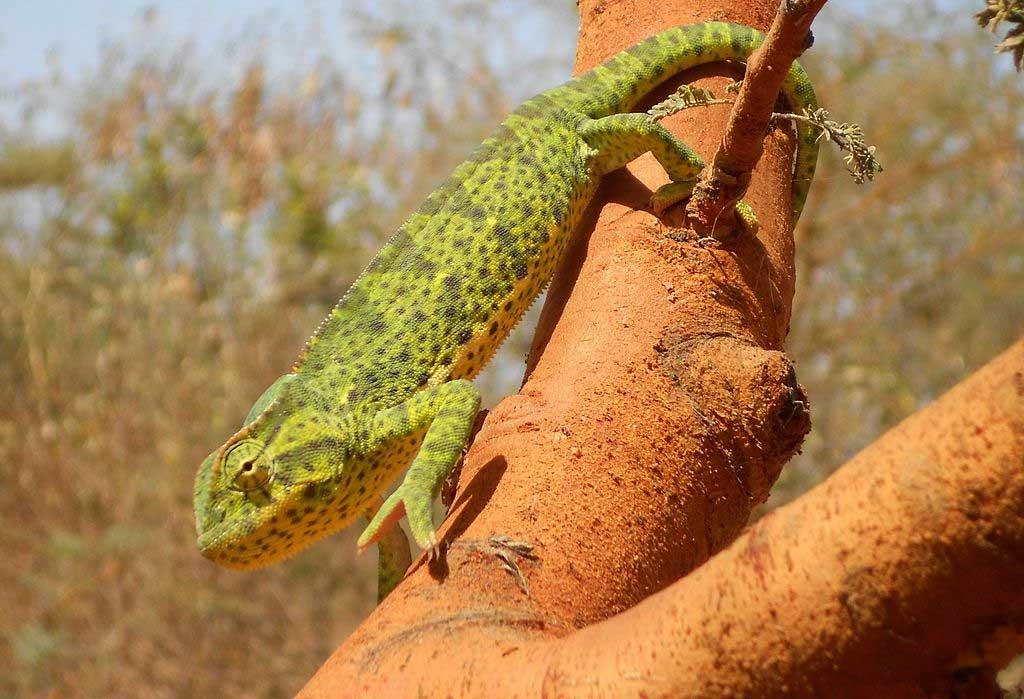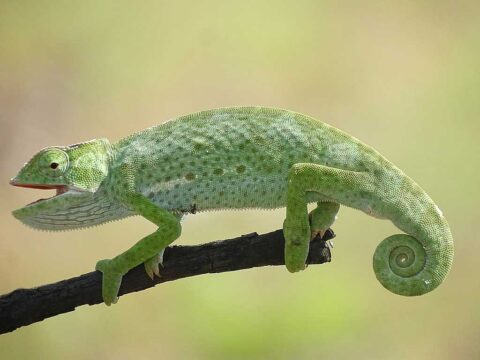
Content |
|---|
Origin / Distribution
The Senegal chameleon (Chamaeleo senegalensis) lives in large areas of West Africa, as Togo, Cameroon and Gambia.
It is also said to be present in Mauritania.
Characteristics / Appearance
The Senegal chameleon shows no conspicuous special features.
hull is low, but the head is clearly separated from the trunk.
The scales on the helmet are larger than those on the body..
Body scales are homogeneous. A light side stripe runs from the chin to the anus. in addition, a slight longitudinal band runs from the armpit to the hips, but without reaching them. Males can reach a total length of 28 cm., of which the tail occupies about half.
Coloration consists of different shades of green.
Males sometimes show a more gray-brown color.
Habitat
Its habitats are savannah and arid forests., but it is also common to find them in inhabited centers.
Behavior
It is a kind of diurnal habits. It feeds on insects and other arthropods..
Threats to the species
Due to its wide range and unknown population, the Senegal chameleon is classified as Least concern on the IUCN Red list. But, may be threatened by the pet trade
The "Senegal chameleon" in captivity

Mira, but don't touch. This is exactly how you should treat your Senegal chameleon. Once your chameleon has settled into its habitat, you should have as little direct interaction with him as possible.
On the other hand, you can tell how your chameleon is feeling based on its color change. If the chameleon is depressed, you will notice that its color is not so bright and vibrant. And if you're really upset, will turn brown and black. But when you see them bright and colorful, you'll know they're alright.
The Senegal chameleon is an amazing creature with some of nature's most unique abilities. And they are docile pets that are best left under observation. But that doesn't mean they're easy to care for..
Like all chameleons, Senegalese require a lot of time, energy and resources. You have to be very prepared to assume the commitment of having and raising one. As wonderful as they are, You shouldn't jump headlong into chameleon parenting without a bit of experience..
The terrarium
When you build your chameleon's habitat, you'll want to make sure he has plenty of room to move around and plenty of tree branches to climb on. We recommend that, in fact, build your habitat more vertically than horizontally.
Lighting and heating
the body of your Senegal chameleon is attuned to a very specific environment. And if you are going to raise a healthy lizard, you will have to do your best to reproduce those conditions. Your enclosure should have heat lamps strategically placed to allow for three different temperature zones:
- 30º: Sunbathing
- 24º: For the day
- 22º: For the night
You will also need UV lamps to help your chameleon stay healthy.. These lights are used to help regulate your metabolism, the appetite, and synthesize vitamin D. Vitamin D is exceptionally important for chameleons, as it helps strengthen your bones and joints.
If possible, you should spend time exposing your chameleon to direct sunlight for several hours each day. But, this is hardly possible. Thus, We recommend getting UV lights with timers that activate on a cycle of 12 power on hours and 12 off hours.
Hydration
Chameleons are native to extremely humid climates.. And without that same humidity and level of hydration inside your house, they won't last long. But it is not as simple as putting a bowl of water in its enclosure..
They drink by licking dew and water droplets from leaves, so you will have to spray them several times a day. This can be done by manual nebulization (that is to say, with a spray bottle) or by automatic means. A drip system or automatic misting system is a good investment to ensure the humidity in your chameleon's enclosure stays high.
Food

The Senegal chameleon lives on a diet strictly based on live insects. This means you will need to invest in an insect habitat to meet dietary requirements., unless you like to go to the pet or bait store every day.
It is also worth mentioning that these insects must be fed by the intestine.. This means that the insects must be fed special food that, when ingested, add more nutrition to your chameleon's diet. There is also a special calcium powder that you can put on the bugs to help prevent bone disorders in your lizard..
When you feed your chameleon, it is important not to put too many insects at once. Your lizard will not overfeed, which means the leftovers will be left around the cage. Dead insects will begin to decompose, making your chameleon more susceptible to disease. Live insects can also clump together and attack your chameleon. In any case, not good.
Health and conditions
The Senegal chameleon well cared for it can be quite a strong creature. But, you may have a rocky start even when you first get it. These chameleons are usually caught in the wild. The shipping and transportation process alone can wreak havoc on their delicate constitutions.. Not only that, but their wild diet makes them more prone to parasitic infestation.
Your chameleon may already have a stress-related illness when you bring him home. The best way to care for him back to health is to make sure he has a suitable environment and give him his space.. Really, they don't want to be manipulated. That can complicate things even more.
One of the diseases caused by the stress of transport is known as dystocia. This occurs when egg-carrying females have depressed calcium levels or are too stressed and dehydrated to expel the eggs they are carrying.. Without the intervention of a veterinarian, it's a death note for them.
Another major problem your chameleon can suffer from is dehydration.. Although it is common for your new lizard to be dehydrated upon arrival, dehydration can also occur in long-term captives. That is why it is so important to put an automatic drip or mist system in your enclosure and maintain humidity.
Male vs female
Both males and females of the Senegal chameleon they are very similar in nature. Its color ranges from olive green to light brown., with more intense color bursts depending on the temperature, humidity and mood. Females tend to be slightly larger and more aggressive in this species of chameleon..
Buy one "Senegal chameleon"
when you buy a Senegal chameleon, you should first try to find out if it was bred in captivity or not. Wild-caught chameleons are not as robust as those bred in captivity, and they may have diseases or disorders when you buy them. It is also not known exactly what they have eaten in the wild. This means they are more than likely to have harmful intestinal bacteria or parasites.. If you acquire a wild-caught chameleon, you'll need to take him to the vet for very regular fecal tests to ensure your lizard's gut health.
It also, you should be careful if you get a breeding pair. The females of Senegal chameleon can put up 70 eggs per year. at that rate, soon you will be invaded by chameleons. And many of them may not survive just because of the stress.
The actual base cost of a Senegal chameleon is of some 40 EUR. With that you already have the lizard. But we would be lying if we didn't tell you that owning a chameleon can be very expensive.. It's everything else that goes into raising a chameleon properly that makes them such an impactful addition to your portfolio..
Chameleons need very specific conditions to live and stay healthy. This includes hydration and moisture, temperature and even ultraviolet light. To meet these conditions, you will have to buy a combination of heat lamps, UV lamps, nebulizers and other control instruments. And you will have to have live food on hand every day.
Videos "Senegal chameleon"
|
|
|
|---|
Alternative names:
1. Senegal chameleon (English).
2. Caméléon du Sénégal (French).
3. Senegalesische Chamäleon (German).
4. Camaleão do Senegal (Portuguese).
5. "Camaleón de Senegal" (español).